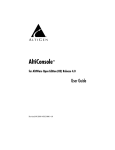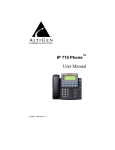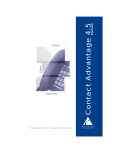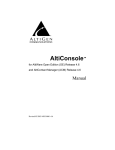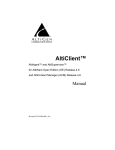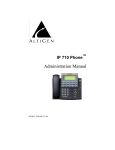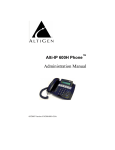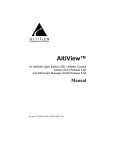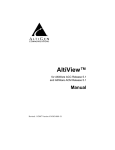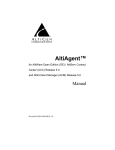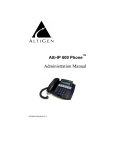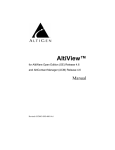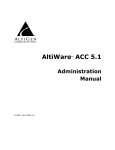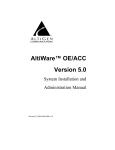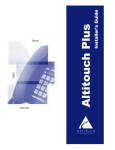Download Altigen AltiView Release 4.0 User guide
Transcript
AltiView ™ for AltiWare Open Edition (OE) Release 4.0 User Guide Revised: 09/2000 4503-0001-4.0 WARNING! Toll fraud is committed when individuals unlawfully gain access to customer telecommunication systems. This is a criminal offense. Currently, we do not know of any telecommunications system that is immune to this type of criminal activity. AltiGen Communications, Inc. will not accept liability for any damages, including long distance charges, which result from unauthorized and/or unlawful use. Although AltiGen Communications, Inc. has designed security features into its products, it is your sole responsibility to use the security features and to establish security practices within your company, including training, security awareness, and call auditing. NOTICE While every effort has been made to ensure accuracy, AltiGen Communications, Inc. will not be liable for technical or editorial errors or omissions contained within the documentation. The information contained in this documentation is subject to change without notice. This documentation may be used only in accordance with the terms of the AltiGen Communications, Inc. License Agreement. AltiGen Communications, Inc. 47427 Fremont Blvd. Fremont, CA 94538 Telephone: 510-252-9712 Fax: 510-252-9738 E-mail: [email protected] Web site: www.altigen.com TRADEMARKS AltiGen, AltiServ, AltiWare, AltiSpan, AltiReach, AltiLink, AltiConsole, AltiAdmin, AltiView, AltiAgent, AltiSupervisor, Center, Zoomerang and Dynamic Messaging are trademarks or registered trademarks of AltiGen Communications, Inc. All other brand names mentioned are trademarks or registered trademarks of their respective manufacturers. Copyright © AltiGen Communications, Inc. 2000. All rights reserved. Printed in U.S.A. 09/2000 Part Number 4503-0001-4.0 Table of Contents Contents WARRANTY . . . . . . . . . . . . . . . . . . . . . . . . . . . . . . . . . . . . . . . . . . . V C HAPTER 1 Installation . . . . . . . . . . . . . . . . . . . . . . . . . . . . . . . . . . . . . . . . . 1 Client System Requirements . . . . . . . . . . . . . . . . . . . . . . . . . . . . . . Session Licensing and License Upgrade Procedures . . . . . . . . . . . . Installation and Setup . . . . . . . . . . . . . . . . . . . . . . . . . . . . . . . . . . . . Pre-Installation Checklist . . . . . . . . . . . . . . . . . . . . . . . . . . . . . . . Installing AltiView on a Client System . . . . . . . . . . . . . . . . . . . . Installing AltiView Voice Mail Service on AltiServ . . . . . . . . . . Uninstalling AltiView. . . . . . . . . . . . . . . . . . . . . . . . . . . . . . . . . . Uninstalling AltiView Voice Mail Service at AltiServ . . . . . . . . Microsoft Outlook Support . . . . . . . . . . . . . . . . . . . . . . . . . . . . . . . ACT/GoldMine Support . . . . . . . . . . . . . . . . . . . . . . . . . . . . . . . . . 1 2 4 4 4 4 5 5 5 5 C HAPTER 2 Getting Started . . . . . . . . . . . . . . . . . . . . . . . . . . . . . . . . . . . . . 7 Logging In . . . . . . . . . . . . . . . . . . . . . . . . . . . . . . . . . . . . . . . . . . . . 7 Logging in from a Remote Location (IP Extension) . . . . . . . . . . . . 8 Hiding or Exiting AltiView . . . . . . . . . . . . . . . . . . . . . . . . . . . . . . . 9 Using the Windows Tray Phone Icon . . . . . . . . . . . . . . . . . . . . . 10 Resizing the Display . . . . . . . . . . . . . . . . . . . . . . . . . . . . . . . . . . 10 Call States . . . . . . . . . . . . . . . . . . . . . . . . . . . . . . . . . . . . . . . . . . . . 11 Error Messages . . . . . . . . . . . . . . . . . . . . . . . . . . . . . . . . . . . . . . . . 12 C HAPTER 3 Using AltiView . . . . . . . . . . . . . . . . . . . . . . . . . . . . . . . . . . . . 15 About the Main Window . . . . . . . . . . . . . . . . . . . . . . . . . . . . . . 15 About the Calls List . . . . . . . . . . . . . . . . . . . . . . . . . . . . . . . . . . 16 Handling Calls . . . . . . . . . . . . . . . . . . . . . . . . . . . . . . . . . . . . . 17 Dialing . . . . . . . . . . . . . . . . . . . . . . . . . . . . . . . . . . . . . . . . . . . . . . Dialing By Number. . . . . . . . . . . . . . . . . . . . . . . . . . . . . . . . . . . Dialing By Name or Extension. . . . . . . . . . . . . . . . . . . . . . . . . . Dialing Speed Dial Numbers . . . . . . . . . . . . . . . . . . . . . . . . . . . Placing Calls on Hold . . . . . . . . . . . . . . . . . . . . . . . . . . . . . . . . . AltiView 4.0 User Guide 17 18 18 19 19 iii Table of Contents Using Call Waiting. . . . . . . . . . . . . . . . . . . . . . . . . . . . . . . . . . . Transferring Calls. . . . . . . . . . . . . . . . . . . . . . . . . . . . . . . . . . . . Sending Calls to Voice Mail . . . . . . . . . . . . . . . . . . . . . . . . . . . Conferencing Calls. . . . . . . . . . . . . . . . . . . . . . . . . . . . . . . . . . . 20 20 21 21 Using Voice Mail . . . . . . . . . . . . . . . . . . . . . . . . . . . . . . . . . . . 23 About the Voice Mail Window . . . . . . . . . . . . . . . . . . . . . . . . . Listening to Your Voice Mail. . . . . . . . . . . . . . . . . . . . . . . . . . . . . Saving Remotely or Locally. . . . . . . . . . . . . . . . . . . . . . . . . . . . Deleting the Message . . . . . . . . . . . . . . . . . . . . . . . . . . . . . . . . . Returning the Call . . . . . . . . . . . . . . . . . . . . . . . . . . . . . . . . . . . Attaching a Memo . . . . . . . . . . . . . . . . . . . . . . . . . . . . . . . . . . . Forwarding Voice Mail . . . . . . . . . . . . . . . . . . . . . . . . . . . . . . . Working with Voice Mail Groups (Distribution Lists) . . . . . . . Creating a VM Group. . . . . . . . . . . . . . . . . . . . . . . . . . . . . . . . . Changing a VM Group . . . . . . . . . . . . . . . . . . . . . . . . . . . . . . . . Deleting a Group . . . . . . . . . . . . . . . . . . . . . . . . . . . . . . . . . . . . 23 24 24 24 25 25 26 27 28 28 29 Monitoring Extension Activity . . . . . . . . . . . . . . . . . . . . . . . . . 30 Choosing Extensions to Monitor . . . . . . . . . . . . . . . . . . . . . . . . . . 30 Reading the Monitor List . . . . . . . . . . . . . . . . . . . . . . . . . . . . . . 31 Viewing the Call History . . . . . . . . . . . . . . . . . . . . . . . . . . . . . . . . 32 CHAPTER 4 Configuring Your Station Settings . . . . . . . . . . . . . . . . . . . . 35 Apply Button and OK Button. . . . . . . . . . . . . . . . . . . . . . . . . . . General Information . . . . . . . . . . . . . . . . . . . . . . . . . . . . . . . . . . . . Default Trunk Access. . . . . . . . . . . . . . . . . . . . . . . . . . . . . . . . . Voice Mail Play Options . . . . . . . . . . . . . . . . . . . . . . . . . . . . . . Screen Pop and Auto Close . . . . . . . . . . . . . . . . . . . . . . . . . . . . Accessing Databases . . . . . . . . . . . . . . . . . . . . . . . . . . . . . . . . . Call Handling . . . . . . . . . . . . . . . . . . . . . . . . . . . . . . . . . . . . . . . . . One Number Access . . . . . . . . . . . . . . . . . . . . . . . . . . . . . . . . . . . . Message Notifications . . . . . . . . . . . . . . . . . . . . . . . . . . . . . . . . . . Station Speed Dialing Setup . . . . . . . . . . . . . . . . . . . . . . . . . . . . . . Adding or Editing Station Speed Entries . . . . . . . . . . . . . . . . . . System Speed Dialing . . . . . . . . . . . . . . . . . . . . . . . . . . . . . . . . 35 36 36 37 37 37 38 40 43 44 45 45 INDEX . . . . . . . . . . . . . . . . . . . . . . . . . . . . . . . . . . . . . . . . . . . . . . . 47 iv AltiView 4.0 User Guide Warranty Coverage AltiGen Communications warrants its hardware products to be free from defects in material and workmanship during the warranty period. If a product proves to be defective in material or workmanship during the warranty period, AltiGen Communications will, at its sole option, repair, refund or replace the product with a like product. Length of Warranty All AltiGen Communications products are warranted for one (1) year for all parts from the date of the first consumer purchase. Who the Warranty Protects This warranty is valid only for the first consumer purchaser. What the Warranty Does Not Cover 1. Any product on which the serial number has been defaced, modified or removed. 2. Damage, deterioration or malfunction resulting from: a. Accident, misuse, neglect, fire, water, lightning, or other acts of nature, unauthorized product modification, or failure to follow instructions supplied with the product. b. Repair or attempted repair by anyone not authorized by AltiGen Communications. c. Any damage of the product due to shipment. d. Removal or installation of the product. e. Causes external to the product, such as electric power fluctuations or failure. f. Use of supplies or parts not meeting AltiGen Communications’ specifications. g. Normal wear and tear. h. Any other cause which does not relate to a product defect. i. Removal, installation, and set-up service charges. AltiView 4.0 User Guide v Warranty Service End user customers should contact your Authorized AltiGen Dealer for service. Authorized AltiGen Dealers must follow the steps below for service: 1. Take or ship the product, prepaid, to your AltiGen distributor or to AltiGen Communications, Inc. All materials being returned to AltiGen must have an associated RMA number. RMA numbers are issued by AltiGen Customer Service and can be obtained by calling 1-888-ALTIGEN (258-4436) or faxing an RMA form (See Appendix C) to 510-252-9738, attention to Customer Service. AltiGen reserves the right to refuse return of any material that does not have an RMA number. The RMA number should be clearly marked on the outside of the box in which the material is being returned. Please see the example below: Attn.: RMA # 123 AltiGen Communications, Inc. 47427 Fremont Blvd. Fremont, CA 94538 Upon authorization of return, AltiGen will decide whether the malfunctioning product will be repaired or replaced. 2. To obtain warranty service, you will be required to provide: a. the date of purchase b. serial number of the product c. your name and company name d. your shipping address e. a description of the problem. 3. For additional information contact your AltiGen Dealer or AltiGen Communications, Inc. directly at 1-888-ALTIGEN (258-4436) or via e-mail at [email protected]. Limitation of Liability Except for personal injury, direct damages to tangible personal property proximately caused by AltiGen products and liability otherwise expressly assumed in a written agreement signed by AltiGen, the liability of AltiGen, its affiliates, suppliers, and authorized resellers for any claims, losses, damages, or expenses from any cause whatsoever (including acts of omission of third parties), regardless of the form of action, whether in vi AltiView 4.0 User Guide contract, tort or otherwise, shall not exceed an amount equal to the lesser of the direct damages proven or the purchase price of the product. In no event shall AltiGen or its affiliates, suppliers, or authorized resellers be liable for incidental, consequential or any other indirect loss or damage (including lost profits or revenues) incurred in connection with the product. This limitation of liability shall survive failure of the exclusive remedy set forth in the limited warranty above. Effect of State Law This warranty gives you specific legal rights, and you may also have other rights which vary from state to state. Some states do not allow limitations on implied warranties and/or do not allow the exclusion of incidental or consequential damages, so the above limitations and exclusions may not apply to you. Sales Outside the U.S.A. For AltiGen Communications products sold outside of the U.S.A., contact your AltiGen Communications dealer for warranty information and services. AltiView 4.0 User Guide vii Warranty viii AltiView 4.0 User Guide Client System Requirements CHAPTER 1 Installation Installation The following items are included in the AltiView 4.0 package: • AltiView 4.0 CD ROM • AltiView 4.0 User Guide If any of these items are missing or damaged, please contact your Authorized AltiGen dealer. Client System Requirements The client system must each meet the following minimum requirements. For server system requirements, see the Altiware Getting Started Manual. • IBM/PC AT compatible system • Intel 133 MHz Pentium • Windows 95 (with DCOM95 installed), or Windows 98 (or higher), or Windows 2000, or Windows NT 4.0 or higher, Server or Workstation. • 30 MB Hard Drive Disk Space • 32 MB RAM • SVGA monitor (800 x 600) with 256 color display, or better • Keyboard and Mouse • AltiWare OE Release 4.0 running on a server accessible to this client. AltiView is call management software that runs with the AltiWare OE 4.0 system. The AltiView software can be installed on a Windows 95/98/2000 or Windows NT PC. To install the AltiView client software, you can load AltiView client on a network server and then using your company’s distribution software, deliver the AltiView client software to each desktop PC. Most frequently, this means loading the software onto a shared network file server and copying the software to each desktop PC. Alternatively, you can use AltiView CD ROM to install the program on each desktop. AltiView 4.0 User Guide 1 Installation Session Licensing and License Upgrade Procedures AltiWare OE (Release 4.0 or higher) comes with one free licensed connection to support an AltiView client. You can upgrade to Center, an application which includes AltiView as well as AltiAgent (for workgroup agents) and AltiSupervisor (for workgroup supervisors) by purchasing a Center Server License and adding client sessions. If you upgrade to Center, session licenses can be added to the AltiWare server at any time and in discrete numbers: e.g. 4, 8, 16 and/or 32 simultaneous sessions. For example, to provide 24 desktops with 24 simultaneous connections, the installer will enter two purchased license numbers; one for 8 licenses and one for 16 licenses using the upgrade installation procedures. The system will have a capacity of 25 total simultaneous connections. Further, if the customer later wants an additional 6 more simultaneous connections, he would purchase another 8-user license (the closest number to 6). The installer would enter the license number and AltiWare will add this number to the system’s total, providing this customer with a total of 33 (8+25) simultaneous connections. The AltiWare server does not need to be rebooted to activate these new connections. AltiView 4.0 software is packaged in different simultaneous session licenses. Each package consists of the AltiView 4.0 installation CD, manual and licensing for a particular number of sessions. Customers purchase one or more of these packages for the desired capacity of simultaneous AltiView users. For example, if purchasing the 16 sessions license for a group of 20 people, all 20 workstations can have AltiView installed, but only 16 workstations can use AltiView at the same time. Software 2 Model Number AltiView 4.0 User Guide # of (Simultaneous) Sessions License Session Licensing and License Upgrade Procedures Upgrading Licenses Installation To increase the number of simultaneous AltiView sessions, follow these steps: 1. Insert the AltiWare CD into the CD drive. 2. Run the SETUP.EXE in the AltiWare OE folder to run the setup program. 3. Select the Upgrade Port License option and click OK. 4. Enter the 20-digit software license key located on the End User License Agreement shipped with your upgrade package and click Next. 5. After the code is validated, the system will confirm that the upgrade was successful and ask if you wish to add additional licenses. You can add additional licenses now or at any point later by following this procedure. 6. You can verify the new number of extensions when you run AltiAdmin by selecting About AltiWare… on the Help menu, then clicking the License Information button to view a window that displays licenses and session information. AltiView 4.0 User Guide 3 Installation Installation and Setup Pre-Installation Checklist Before installation AltiView, please review the following checklist: • Make sure that AltiWare OE 4.0 has been installed on the AltiServ system. • Make sure that AltiView VM Service has been installed on the AltiServ system, as discussed in a subsequent subsection. • Make sure that TCP/IP is enabled on both machines. • Make sure the client is able to connect to the server on the network. Installing AltiView on a Client System After completing the pre-installation checklist, proceed as follows on the client machine: 1. Exit any/all Windows applications. 2. Insert the AltiWare CD into the CD ROM drive. 3. Run the Setup program under AltiView\AltiView Client and follow the step by step installation instructions as they appear on the screen. Installing AltiView Voice Mail Service on AltiServ AltiGen Switching Service must be installed first. AltiGen Switching Service is installed and run when you install AltiWare and anytime you run the AltiWare Administrator. 1. On the client system, locate AltiServ on the network. 2. Run SETUP.EXE under AltiView\AltiView VM Service directory and follow the prompts. 3. Access Services from the Control Panel on the NT or from Programs Administrative Tools Component Services on Windows 2000. 4. Highlight AltiView Voice Mail Service and click Start. 4 AltiView 4.0 User Guide Microsoft Outlook Support Uninstalling AltiView From the Windows Start menu, select Programs Uninstall AltiView. AltiView 2. Click OK when the dialog box asks if you want to uninstall the program, and respond to any additional prompts. Installation 1. Uninstalling AltiView Voice Mail Service at AltiServ 1. From the Windows Start menu, select Programs Service Stop AltiView VM Service. AltiView VM 2. In the Control Panel, select Add/Remove Programs. 3. Choose AltiView VM Service and click the Add/Remove or Change/ Remove button, depending on which version of Windows you’re running. 4. Click OK to in the dialog box to confirm you want to remove the service, and respond to any additional prompts. Microsoft Outlook Support AltiView supports Microsoft Outlook 97, 98, and 2000, permitting the AltiView user to obtain phone numbers to dial from Outlook’s Contact Lists. AltiView also allows the user to see the incoming calls which have a matching record in the Outlook Contact Lists. AltiView requires that you to set up the Microsoft Contacts list prior to using this feature in AltiView. ACT/GoldMine Support AltiView supports ACT 2000 and GoldMine 5.0 contact management software, allowing the AltiView user to access contact lists from ACT or GoldMine contact records. AltiView 4.0 User Guide 5 Installation 6 AltiView 4.0 User Guide Logging In CHAPTER 2 Getting Started • l or external CDR database for future review and analysis. Logging In Before you log in When you log in for the first time, you need to know either the server name or the IP address of the server you’ll be linking to. If you use the server name and not the IP address, AltiView replaces the name with the IP address, eliminating the need of a DNS (Domain Naming System) search. To obtain the AltiServ IP address, ask your IT administrator. If you are connecting to the Internet through a modem connection, before you log in, establish a session connection from your PC to your local Internet Service Provider. If you’re using a low-speed connection, the login may take some time as a large amount of data is transferred to your desktop. AltiView 4.0 User Guide 7 Getting Started AltiView 4.0 is designed for general desktop PC users in an AltiServ environment. With AltiView you can access, configure and perform several of AltiServ’s PBX functions directly from the desktop. These functions include call handling, call forwarding, voice messaging, extension monitoring, and One Number Access. In addition, AltiView integrates with contact management software including Microsoft Outlook, ACT and GoldMine. Getting Started To Log In 1. Run the AltiView application and, if this is the first login to this AltiServ system, enter the servers IP address or name of the system you will be using. If this is not your first login, go on to the next step. Figure 1. Logging In 2. Enter your Extension number and Password assigned to your phone. Optionally, you can check the Always save password check box to store your login password the next time you access AltiView. 3. If you’re using an IP extension, select the IP Extension Integrated with NetMeeting check box to access AltiView through an IP extension. To do this, the extension must be set up as in IP extension in AltiAdmin and you must have Microsoft NetMeeting 3.01 or higher installed on your desktop. Refer to the discussion in the next subsection for more information on using IP extensions. If you’re using an Internet Phone Jack or IP phone, do not select the IP Extension Integrated with NetMeeting check box. 4. Click OK to complete the login. Logging in from a Remote Location (IP Extension) You can access AltiView from a remote location using an IP extension. All the call handling functions are the same as logging in locally, with the exception of the ability to configure One Number Access. You can pick up voice mail, forward local business office phone calls to another site such as a home desktop PC, and even receive the phone calls as you would at the office. 8 AltiView 4.0 User Guide Hiding or Exiting AltiView In order to run AltiView remotely, if you connect to the Internet through a modem connection, first you need to establish a session connection to your Internet Service Provider. To use AltiView remotely through an IP Extension, follow the steps below. Check with your administrator to make sure the extension you’re using has been set up as an IP extension in AltiAdmin. 2. If you are not already running NetMeeting 3.01 or higher, download and install it from Microsoft’s web or FTP sites. 3. Leave the IP Extension Integrated with NetMeeting check box unchecked unless you specifically want to use that option. (See Figure 1 on pa ge8.) 4. Click OK. Note for those using the IP Extension Integrated with NetMeeting option. AltiView uses conferencing features that require the same data channels as NetMeeting. If NetMeeting is running, you will see a prompt reminding you to close the program. Troubleshooting IP Connectivity If problems occur, they may be due to a failure to connect to your ISP provider or due to firewalls at your work preventing direct access to the AltiServ server. For firewall installation, see the AltiWare Getting Started Manual chapter on Software Installation. As a test, you can choose Run from the Windows Start menu, then enter Ping <IP address> [ENTER] where <IP address> is the AltiServ system you want to connect to. An example of the IP address form is 123.234.231.143 If you do not get a response, contact your LAN administrator for support. Hiding or Exiting AltiView When you minimize the AltiView desktop by clicking the Minimize symbol (the dash), it is hidden—it doesn’t appear anywhere in the Windows desktop except as a phone icon in the tray in the lower right corner, as discussed in a following subsection. To exit AltiView entirely, right click the phone icon and select Exit. AltiView 4.0 User Guide 9 Getting Started 1. Getting Started Pop Up AltiView when You Get a Call You can configure AltiView to pop up when you have incoming calls. Pop ups work when AltiView is hidden (minimized) but not when you have exited. See “Screen Pop and Auto Close” on page55. Using the Windows Tray Phone Icon After you log in, the AltiView icon (a phone) is displayed on the Windows tray, normally at the bottom right of your screen. When you have new voice mail, the phone grows a little yellow envelope, as shown in the lower icon. If the AltiView interface is not on your Windows desktop, but this icon appears in the Windows tray, you double-click it to open the AltiView main window, or you can right click it to pop up a menu, then select the AltiView window you want to open. Resizing the Display You can re-size many AltiView windows in the normal Windows method: place the cursor at a window edge or corner, then drag the window to the size you want. Also, the field size for any field can be increased or decreased by pointing the cursor to either side of the field’s main column. The cursor changes to a movable double bar (||) that can be moved to resize the column. 10 AltiView 4.0 User Guide Call States Call States Center applications all report the status of calls. A list of the states includes the following: • AA - the call is being transferred to an Auto Attendant. Getting Started • Busy - callee is busy or not available • Call Pending - the call is placed into a workgroup queue • Conference - the call is in conference • Connect - the call is connected • Dial Tone - a dial tone is present, AltiView is ready to dial out. • Error - receipt of an error tone • Hold - the call is on hold. • Hold Pending - the call is being transferred or conferenced. • Idle - the extension is not in use. • Music on Hold - an extension user placed the call on hold to take another call • Park - the call is parked • Play - Playing voice mail • Proceeding - the outgoing call is in progress • Record - Recording an introductory message • Ringback - Caller receives this state while callee is ringing • Ringing - there is an incoming call • Voice mail - the call is in voice mail AltiView 4.0 User Guide 11 Getting Started Error Messages The following errors may be displayed as login or connectivity errors. Error Message Description Solution ! "## $ # $ %! & % ## %! & ## ( % '# ( )& %( '( * ' %' # # " %! # # " %! ! !# & # # " %! &(% )+,- %( 1% # ./ &# 20 . ## 34 5 !67 / 0 / 0(( / / ## , 6 %( 0 ## & 2& %( 34  . ( ( ! % !" #6 !( # $ !" % !6 $ # ' 6 % ! * 6 ( $ % ! 0 / 6% # !# $ / % # 4$( #6 %# !6 '' * 6% ! 0 " ( # 4$( 12 AltiView 4.0 User Guide ./ & & " 6% '%8 6 & 8 * 6 ((( 0 " ' Error Messages Error Message Solution / % # % %# ! (# % 6 -( & 9 :. ; # 6' # #* ( ( .# #& # -<%# ,' 0 / . ' ' / 6 <%# !% 0 # 6% # $ / % 6% ( ' # 6 ! !" 1% # # ' # 0 6 ( ' # # & !" # 1% # 4$( % :0 " ( # 4$( = 1% # ( 4$( 0 " ' ( & $&8 ! +0 % # & 4$( AltiView 4.0 User Guide 13 Getting Started 0 ( .#& # 2( .#& #5 Description Getting Started 14 AltiView 4.0 User Guide CHAPTER 3 Using AltiView Once you log in as described on page 7, the AltiView main window appears. This window provides tools to manage and monitor calls, to facilitate management of your personal contacts, and to configure your AltiServ phone and voice mail options. Configuration is described in Chapter 4. AltiView Call Status Lists of Calls / Voice Messages Dial Buttons Call Controls Figure 2. AltiView main window About the Main Window The window consists of the following displays and buttons: • The Call Status panel displays the status of the currently active call, a list of any calls on hold, and the current time. • The Directory panel has two tabs: one showing a log of current calls, the other showing a log of current and past voice mails. • The Dial functions provide buttons to place, hold or redial calls • The Call Control buttons provide call functions such as transferring the call or sending it to voice mail. AltiView 4.0 User Guide 15 Using AltiView • The Configuration button allows you to customize your call handling and voice message settings. See “Configuring Your Station Settings” on pag e35. • The Monitor button provides a view into extension or workgroup activity and provides access to past call logs. About the Calls List Figure 3. Calls List The calls list displays the call status for each call as described on page 11. The list also displays the name of the caller if available from extension information or from an external database, the number, workgroup pilot extension number, DNIS digits if available, and call duration. 16 AltiView 4.0 User Guide Dialing Handling Calls Dialing You can dial out in a number of ways: using the numeric keyboard or using the mouse, and by name or extension, number, or speed dial number. Initiate dialing by clicking the dial button in the main window. As a list, it displays tensions and the names associated with extensions as well as names and numbers imported from MS Outlook, Goldmine, or ACT. You can select extensions or names using the scroll list. The list can display up to 2000 entries. If you are working with more than 2000 entries, you can find the entry by name search even if the entry is not one of the first 2000 that are displayed.t Figure 4. Dialing pad, also known as the Dialing window AltiView 4.0 User Guide 17 AltiView Clicking the Dial button opens the dialing window. The scroll list box in the upper left is actually a combination text- and list- box. As a text box, it displays numbers that you enter from the dialing pad or from the keyboard number keys. You can also use it to search for names. Handling Calls Dialing By Number Using the keyboard number keys 1. In the dialing window, enter the numbers you wish to dial using the standard numeric keys or the numeric keypad. The numbers appear in the box above the dialing pad. 2. Press Enter or click the Dial button to place the call. Using the Mouse 1. Using the dialing pad in the Dialing window, click the digits for the phone number. As you enter the numbers, they appear in the list box above the dialing pad. 2. Click the Dial button to place the call. The main window displays the status of the call, and once the call is initiated, the Dial button in the main window becomes a Hang Up button. Figure 5. Call status displays in Calls list as well as status panel Dialing By Name or Extension 1. Use the scroll list box above the dialing pad to select the name or extension. 2. Click the Dial button to place the call. 18 AltiView 4.0 User Guide Placing Calls on Hold Searching by Name 1. Click anywhere in the text box above the dialing pad, then begin to type the name of the person you want to call. The dialing pad transforms into a list that displays matching names. 2. Click the name you want. The extension or number appears in the list box, selected for dialing, 3. Click the Dial button to place the call. Dialing Speed Dial Numbers See “Adding or Editing Station Speed Entries” on page 45 for details on setting up speed dial numbers. 1. Depending on which type of speed dial number you want to call, click the Station Dial tab or the System Dial tab. 2. Choose the speed dial entry from the list. 3. Click the Dial button to place the call. Redialing To redial the last number called, click the Redial button. Placing Calls on Hold During a phone conversation, click the Hold button in the AltiView main OR press the FLASH button on your phone, if available. The state of the call is changed from connected to a hold state and you will hear the dial tone. In the row displaying the call, the State column shows the call on hold. Click the Hold state cell to release the hold and re-connect the call. AltiView 4.0 User Guide 19 AltiView You can use either your own Station Speed Dial numbers or the System Speed Dial numbers. Handling Calls Using Call Waiting During a call, you may hear a beep indicating that you have another incoming call. To answer the call: 1. Click the Calls tab on the AltiView main window to view the directory of current calls. 2. Find and click the row displaying the incoming call. This places the current call on hold and connects the incoming call. 3. When you are finished, click Hold state cell for the call on hold to reconnect. Transferring Calls AltiView supports both supervised transfer, in which you confirm the transfer, and blind transfer. 1. While connected to a call, click the Transfer button. This pops up the dial pad. 2. On the dial pad, enter the extension or phone number to which to transfer the call to, then click Dial. 3. While AltiView dials the new number, you’re asked to confirm your decision by clicking the OK button in a confirmation dialog box: You can click OK before the party answers to do a blind transfer, or you can wait for the person to answer and then confirm or cancel the transfer. Figure 6. Confirming call transfers At any time before or after the person you’re transferring to answers the phone, you can cancel the transfer by clicking the Cancel button, by closing the dialog box, or by pressing your phone’s FLASH button. If the transfer is cancelled, AltiView reconnects the call to your extension. The call is also reconnected if the third party doesn’t answer. 20 AltiView 4.0 User Guide Conferencing Calls Sending Calls to Voice Mail While connected to call, click To Voice Mail on the main window. When the dial pad appears, choose the extension number to which you want to send the call, then click OK. You can also transfer a call to voice mail before you answer it. Transfer to Attendant While connected to a call, click To Attendant on the main window. Select the operator or an Auto Attendants to transfer to using the drop-down list. Figure 7. AltiView You can also transfer a call to an Attendant before you answer it. Transfer to Auto Attendant Conferencing Calls Any internal user is able to add parties to a conference call. While connected to the first party: 1. Click the Conference button. 2. When the dial pad pops up, enter the extension or phone number you want to conference with, then click Dial. While AltiView dials the new number, the first party goes into Hold Pending state, and you see a confirmation dialog box. Figure 8. Confirming Conference Calls AltiView 4.0 User Guide 21 Handling Calls You can cancel the conference at any time by clicking the Cancel button, closing the dialog box, or by pressing your phone’s FLASH button. Normally, after cancelling you will be reconnected automatically to the initial call. If you are not automatically reconnected and want to reconnect to the first call, click the Hold Pending status representing the call. 3. After the third party connects, you can announce the conference by clicking OK in the dialog box. If the third party does not answer, click the Cancel button. Figure 9. 4. Conference Calls Displayed in Call List Click the Conference button again to initiate the three-way conference. Both calls will be displayed as Conference state. To add another party, click the Conference button and repeat steps 2-4. 22 AltiView 4.0 User Guide Conferencing Calls Using Voice Mail About the Voice Mail Window AltiView Figure 10. Voice Mail window When you click the Voice Mail tab in the main window, you see the voice mail list. • New voice mail messages are indicated by a white, closed envelope icon in the status window of AltiView. • If the new message is urgent, a red envelope icon is displayed. • Heard voice mail messages are indicated by a white, open envelope icon. • If the message is saved, a blue, open envelope icon is displayed. • A paperclip symbol on the envelope indicates an attachment—a voice mail forwarded from another extension. AltiView 4.0 User Guide 23 Using Voice Mail Listening to Your Voice Mail In the Voice Mail list, select the message and use the voice mail controls at the bottom right of the window to play it, rewind, or fast forward. You have several listening options which you configure as described in “General Information” on pag e36. you can listen using the sound card on your PC or your phone. You can play the message while its downloading or wait until it’s completely downloaded to play it. If this is a new message, the envelope icon changes from closed to open, indicating that the message has been heard. As the message is played, the status window displays Play. Use the tape player type buttons to play the message. Rewind Stop Play Fast Forward If you click another message in the list, the current message stops playing. Saving Remotely or Locally You can click the Save As button to save the message as a .wav file that you can play back later. Save As opens a dialog box that lets you choose how you want to save the file. • Save in remote allows you to save local drive space, but to play the saved message, of course, you have to access on the remote server. • Save in local opens a dialog in which you choose a directory and file name for the .wav file, which you can then play on a media player. Deleting the Message To delete the message, select it and click the Delete key. 24 AltiView 4.0 User Guide Listening to Your Voice Mail Returning the Call Click the Return Call button to call back the sender. Attaching a Memo To add a note to accompany a voice mail, click the Memo button to invoke the Memo window. AltiView Figure 11. Attaching a memo to a voice message Type in the memo in the area provided and click OK. The entry will be displayed in Memo field of the voice mail. AltiView 4.0 User Guide 25 Using Voice Mail Forwarding Voice Mail To forward a voice mail message to an extension or to a Voice Mail Group: 1. Select the voice mail in the Voice Mail view of the AltiView main window. 2. Click the Forward button to invoke the VM Forward pop up window. 3. Select the check boxes next to the extensions and/or voice mail groups to which you want to forward the message. If you need to search for a person by name, type the first letters of the name into the Search by Name box. The the matching names display in the list as you type. To select a name, select the check box next to it. 4. Optionally, you can leave an introductory message. Select the Record Introduction Message check box and follow the simple steps below. 5. Click OK to complete the forwarding. Recording an Introductory Message If you selected the Record Introductory Message check box, when you click OK to complete the forward, pick up the phone hand set and you’ll hear a prompt to record the message. After recording the message and pressing the pound key (#), a confirmation appears on screen. Click OK to confirm and complete the action. 26 AltiView 4.0 User Guide Listening to Your Voice Mail Working with Voice Mail Groups (Distribution Lists) You can set up voice mail (VM) groups to forward messages to multiple recipients at the same time. You can set up to 100 personal voice mail groups, each with 64 members. Group members can be any extension or another voice mail group. Voice Mail Groups are also known as Distribution Lists in other AltiWare interfaces. There are two types of voice mail groups you can use: System-based groups are set up in the AltiWare Administrator. You can use but not edit these lists in AltiView. • Personal groups are set up and modified in AltiView or in your AltiMail voice mail system. Accessing Voice Mail Group Lists To work on your personal voice mail groups: 1. In the AltiView main window, click the Voice Mail tab to display the Voice Mail version of the window. 2. Click VM Group button in the Voice Mail list window to invoke the VM Group Edit window. Figure 12. Voice Mail Edit window AltiView 4.0 User Guide 27 AltiView • Using Voice Mail Creating a VM Group 1. To create a VM group after opening the VM Group Edit window, click the New button, which invokes the Create Group window. 1. Use the scroll bar to select a desired Group ID. 2. Enter the VM Group Name and any Comments. These are optional but may help you identify the group. 3. Select the member extensions by selecting the check box next to each extension. 4. When finished, click OK. Click the Clear button to deselect all extensions or click Cancel to exit without saving your edits. Changing a VM Group To add or removing extensions, or change name or comments associated with a group: 1. Access the VM Group window as described on page 27. 2. Click the Change button in the VM Group Edit window to open the Change Group window, similar to the Create Group window above. 3. Make any changes you need to make for the group name, comments, or members. To add or remove a member, select or deselect the check box next to the extension. 28 AltiView 4.0 User Guide Listening to Your Voice Mail Deleting a Group To delete a Voice Mail Group: 1. Access the VM Group window as described on page 27. 2. Click the Change button in the VM Group Edit window to open the Change Group window. 3. Click the Clear button to deselect all extensions. 4. Click OK to save and exit. When you empty a group of members, the group is deleted. AltiView AltiView 4.0 User Guide 29 Monitoring Extension Activity Monitoring Extension Activity If your extension’s configuration in the AltiWare Administrator provides for it, you can monitor the activity on other extensions. If you’re a manager, for example, you might monitor to determine whether you need more resources in a busy environment. Or, for another example, you might use monitoring capability to cover calls for a co-worker, since you can click the ringing phone icon in the monitor list and take the coworker’s call. Figure 13. Monitor window Choosing Extensions to Monitor Open the Monitor window by clicking the Monitor button in the AltiView main window. This allows you to view the status of any extensions or workgroup that your extension configuration allows you to monitor. Choose extensions you wish to monitor by clicking the Change button and selecting or deselecting the check box next to the extensions you want to monitor or stop monitoring, respectively. Also, if you want to monitor extensions recently added to your extension’s monitoring list in the AltiWare Administrator, click the Change button and select the extensions. 30 AltiView 4.0 User Guide Choosing Extensions to Monitor Selecting a group entry displays all the workgroup members in the monitoring window. Deselecting a group entry takes all workgroup member extensions out of the display. Reading the Monitor List In the monitor list, each selected extension is listed along with its State, Number, Name, and Group (workgroup), which shows only if the call is coming into to a workgroup. The state can be one of the following: Idle—the extension is not in use. You can click the State field of an idle extension to have AltiView connect you to that extension. • Connected—the extension is in use. • Ringing—the phone on the extension is ringing. You can click the status box of that extension to answer a call from your own extension. • Conference—the extension in on a conference call • Voice Mail—the extension is in voice mail. • Auto Attendant—the extension is connected to an Auto Attendant • Holding - the extension is on hold Calling or Picking Up Calls If a monitored extension is in an idle state, click the extension’s State field to ring that extension. If the monitored extension is in a ringing state, click the State field to pick up that call. AltiView 4.0 User Guide 31 AltiView • Monitoring Extension Activity Viewing the Call History Click the History tab in the Monitor window to view an informational history of handled calls. Figure 14. History window The list in the History window displays the following fields: • Number—the extension or phone number. Upward arrow icons indicate outgoing calls; downward arrows indicate incoming calls Clicking the Number field dials that number. • Name—Caller ID information, if available; or, Caller Unknown. • Time—the call’s date and time. This history data is sorted by last disconnected and not in the order the call was received. It is therefore possible to have a record with an earlier timestamp followed by a record with a later timestamp. Also, the timestamp for call data is based on the client system, while the timestamp for voice mail messages is from AltiServ. Thus, the times displayed here may not match those in the voice mail view in the main window. • Duration—the length of time of each call. • DNIS—displays DNIS digits collected, if available. • Group— the extension’s workgroup number, if available. • Memo—a note attached to the call. You can add memos by selecting Use the Memo button to open a window to create a note. 32 AltiView 4.0 User Guide Viewing the Call History Deleting Logs To delete a specific call log entry, click the entry to select it, then click Delete. Or, right click the entry and select Delete. To clear the entire call log, click Delete All, or right click any entry and select Delete All. Placing Calls from the History List To call a number or extension in the list, click the number. To attach a memo to a history list entry, click the entry to select it, then click the Memo button to open a Memo dialog box. Create the memo in the Memo text box, then click OK. Printing a History Log Click the Print button to print the log. AltiView 4.0 User Guide 33 AltiView Attaching a Memo to an Entry Monitoring Extension Activity 34 AltiView 4.0 User Guide CHAPTER 4 Configuring Your Station Settings You can configure the following settings and options by clicking the Config button in the main window to open the Config window. General Info—password, default trunk access, and other settings. • One Number Access (ONA)—forwarding of specific incoming calls. This is available only when your extension configuration is set up to allow ONA. • Call Handling—forwarding, busy call, and no-answer call handling. • Message Notify—how and when to notify yourself about incoming voice messages. • Station Speed—your personal speed dial numbers • System Speed—you can view and edit the name and comments, but the not the number itself, of system speed dial numbers. Options are disabled if they are not available. For example, One Number Access must be enabled in the AltiWare Administrator. Further, if you don’t enable ONA as a Call Handling option, you can’t set up and use ONA. Apply Button and OK Button In the Configuration windows, you’ll see two buttons that save your changes: the Apply button and the OK button. • The Apply button saves your changes and lets you continue in the current window. • The OK button saves your changes and closes the current window. AltiView 4.0 User Guide 35 Configuration • Configuring Your Station Settings General Information Figure 15. General Info configuration The General Info tab is the window you see when you first click the Config button in the AltiView main window to open the Config window. In this window, you can edit your password, the default trunk access code, voice mail settings, Center audio and video behavior, and external database access options. Default Trunk Access The trunk access codes are defined in the AltiWare Administrator. When you get an incoming call over multiple trunks and cannot issue a return call, the system will automatically select the default trunk access code to place your call. 36 AltiView 4.0 User Guide General Information Voice Mail Play Options You can choose to play your messages on your phone set, or play them on your sound card and speakers. If you choose to play them on your sound card, you have another choices: you can choose to play the message as it downloads, or to download it completely and play it on an external media player. Screen Pop and Auto Close Select the Screen Pop check box if you want a AltiView window to pop up on your screen when you have a call. You can then click a call to take it or perform other AltiView actions. For AltiView to pop up, you cannot have closed the application entirely, but it can be minimized. Select the Auto Close check box to have AltiView close the popup window once you have finished with the call. AltiView can access phone numbers from your Microsoft Outlook, ACT or Goldmine database. During installation, the install program read which applications you have installed on your PC. In the drop down list under Use Database, select the database you want to use. You have these additional options: • Select the Screen Pop check box to have a database contact window pop up when you receive a call from someone for whom you have a record in the database contact directory. • Select the Dial-by-Name check box enable access to the names in the database directory when you dial. With this option enabled, the names and their associated numbers in your Outlook, ACT or GoldMine directory are added to the contact list in the dial pad window. • Select the Update database right now check box to refresh the data AltiView accesses from the database. AltiView 4.0 User Guide 37 Configuration Accessing Databases Configuring Your Station Settings Call Handling Click the Call Handling tab in the Config window to configure incoming call handling for your extension. Figure 16. Call Handling configuration Forwarding All Calls If you want to forward calls to an external number, select a trunk access code in the drop-down list, then begin with the outside trunk or route access digit and any long distance prefix digits such as 1 and area code. If you want to use One Number Access, see page 40. There is a “1-hop” limit to call forwarding. For example, ext. 101 forwards to ext. 102, and Ext. 102 forwards to ext. 103. A call to ext. 101 will ring ext.102 but will not re-forward to ext. 103 because of the 1-hop limit. Instead, if ext.102 does not answer, the call is sent to ext.101’s voice mail. 38 AltiView 4.0 User Guide Call Handling Forwarding to a Pager Not Recommended Forwarding calls to a pager is possible but not recommended since callers will only hear what is heard when calling a pager and will not know to enter a return phone number unless instructed. Do Not Disturb If you select Enable Do Not Disturb, all incoming calls are forwarded to voice mail. Busy Call Handling and No Answer Handling You can use these options to specify how you want to handle incoming calls when you’re already on the phone or when you can’t answer the phone, for example, when you’ve enabled the Do Not Disturb state. One busy-call handling option, Place call in queue is available only if queueing is enabled for you or for your workgroup. Number of Rings Before Forwarding This setting is pertains to almost all the options on this page: the number of times the phone should ring before the system decides to forward the call to an extension, voice mail, or the Auto Attendant. AltiView 4.0 User Guide 39 Configuration If want to use the Auto Attendant and you don’t know the number of the phrase or menu you want to use, check with your system administrator. Configuring Your Station Settings One Number Access If you are expecting calls that you want to receive regardless of where you are, you can have the system send the call to you by dialing pre-determined numbers based on a pre-determined schedule. When One Number Access (ONA) is active and a call comes in to your extension, the system checks to see if the number represents a call you want to receive. If it finds a match, it calls you at the number you specified. ONA depends on the ability to identify the incoming call by the Caller ID. If the system can’t identify the call, it can’t make a match. If the system is unable to connect the call, the caller is sent into the user’s voice mail. Before You Set Up One Number Access Before you use ONA, you need to make sure your call handling settings are appropriate (see page 43). Also, ONA it must be enabled in the AltiWare Administrator. Also, to use ONA to forward to outside lines, that must also be enabled as an Extension Configuration restriction in the Administrator. Check with your system administrator if you have questions about these settings. All system and extension call restrictions apply for One Number Access. For example, if Do Not Disturb is enabled, the call will go into voice mail and not to the ONA number you specified. So if you want to use ONA, make sure Do Not Disturb is disabled. Or if the line is busy, the call will be handled according to the extension’s Busy Call Handling configuration. 40 AltiView 4.0 User Guide One Number Access Accessing One Number Access Setup After you set the call handling options, click the One Number Access tab in the Config window to open the One Number Access window in which you set ONA options: Configuration Figure 17. One Number Access window • Determine the times you want to be available to ONA callers. This can be at all times, during business hours, during non-business hours, or during schedule-based access.If you select the Enable schedule based access option, a dialog box pops up so that you can set the schedule: AltiView 4.0 User Guide 41 Configuring Your Station Settings Using this dialog box, you can set up to four different schedules. You can enable or disable each schedule by selecting or deselecting its check box. • Enable the Verify Caller ID check box and then specify the incoming phone numbers for ONA. If ONA finds one of these numbers on an incoming call, it will send the call on to you. Caution: If no numbers are entered in the Caller ID verification fields and ONA is enabled, it is made available to every caller. You can enter up to ten phone numbers in the Caller ID verification fields. For local numbers, use 7 digits. For long distance numbers, use 10 digits—area code + local number. Using a Password You can also enter a password number such as “5555” so that a caller who knows this password can use ONA to find you, regardless of where they are calling from. Tell the caller the caller to dial 1 during your personal greeting and then enter the password. • Select the Forwarding Numbers to be used by the system to find you when ONA is active. You can set up to four different numbers— extensions or outside numbers. For outside numbers, use the dropdown list to select the trunk access code you want to use. When ONA is active, the system dials the forwarding number(s) in the order from Forwarding Number 1 through Forwarding Number 4. (This number order does not correspond to the Schedule order—Forward Number 2 is not used first during Schedule Number 2. 42 AltiView 4.0 User Guide Message Notifications Message Notifications Click the Message Notify tab in the Config window to establish how and when you want to be notified about incoming voice messages. Configuration Figure 18. Message Notification options Use this window to set the notification options: • The types of messages on which you want to be alerted: none, urgent messages only, all voice messages, or all voice messages and email too. • Schedule—during what hours you want to be alerted. • How and where to notify you—in the Message Notification by Calling a… options, if you chose to use an outside number, use the drop-down list to select the trunk access you want to use. AltiView 4.0 User Guide 43 Configuring Your Station Settings Station Speed Dialing Setup Click the Station Speed tab in the Config window to assign and store up to 20 Station IDs—speed dial entries. When you add a number, all relevant prefix digits such as trunk or route access number, the long distance prefix 1 and area codes must precede an outside phone number. Station speed dial numbers are also set up by using the #25 feature code on your phone set. Figure 19. 44 Station Speed Dialing setup AltiView 4.0 User Guide Station Speed Dialing Setup Adding or Editing Station Speed Entries 1. Click a Station ID to select it. 2. Click the Edit button. 3. When the Dial Setting dialog box appears, add or edit the Number. Optionally, to aid your memory, add or edit the Name and Comment. 4. Click OK. After you have entered and saved the speed dial number, the number is also displayed and can be used in the Dialing Pad window in the Station Speed panel, as shown in Figur e4 on page17. Deleting Station Speed Entries To delete a speed dial number, click the Station ID and click Edit to open the Dial Setting dialog box. Click Clear and then click OK. System Speed Dialing Click the System Speed tab in the Config window to view the System Speed Dial entries. System speed dial numbers are set up in AltiAdmin, the AltiWare Administrator. In AltiView, you can view and edit the names and comments in order to make the numbers more familiar, but the not the number itself. To edit the name or comment, select the Station ID and click Edit to open a Dial Setting dialog box as shown in Figure20. Modify the Name or Comment, then click OK. The number is also displayed and can be used in the Dialing Pad window in the System Speed panel, as shown in Figure4 on pa ge17. AltiView 4.0 User Guide 45 Configuration Figure 20. Dial Setting dialog box, for Speed Dial Numbers Configuring Your Station Settings 46 AltiView 4.0 User Guide Index D Index A AA state 11 ACT 5, 37 advanced database option AltiAgent configuration 35 AltiGen ii AltiGen Communications phone numbers ii AltiGen services 4 AltiView configuration 35 main window 15 Apply button 35 auto attendant 21 38 B busy call handling Busy state 11 39 databases 5 advanced options 38 deleting logs 33 dial-by-name 38 dialing by name 18 by name search 19 by number 17 keyboard dialing pad 18 speed dial 19 using the mouse 18 dialing window (dial pad) 17 dialtone 11 distribution lists 27 Do Not Disturb 39 E Error call state 11 error messages 12 exit 10 external databases 5 C F call handling 17–22 configuration 38 call history 32 call holding 19 Call Pending state 11 call states, defined 11 call transfer 20 call waiting 20 calls list 16 Center configuration 35–45 conference call 21 Conference state 11 configuration 35, 35–45 call handling 38 general 36 message notification 43 One Number Access 40 station speed dialing 44 connected 11 flash button 19 forwarding all calls 38 forwarding voice mail 26 G general configuration GoldMine 5 Goldmine 37 36 H AltiView 4.0 User Guide Index handling calls 17–22 hiding Center 9 history logs 32 history window 32 hold 11 hold button 19 hold pending 11 47 Index I Idle state 11 installation requirements 1 IP extension 8 IP extension, troubleshooting 9 L licenses 2 logging in remotely 8 M Microsoft Outlook 5, 37 minimize 10 monitor window 30 monitoring 30–33 mouse dialing 18 Music on Hold state 11 Ringback state ringing 11 11 S saving changes 35 screen pop 10, 38 search by name 19 session licensing 2 speed dial 19 state column 19 station speed dialing configuration 44 switching service 4 system requirements 1 system speed dialing 45 T NetMeeting 38 no answer handling 39 notifications 43 TCP socket 9 transfer calls 20 transfer to auto attendant 21 transfer to voice mail 20 transferring calls to voice mail 21 Troubleshooting IP Connectivity 9 O U OK button 35 One Number Access configuration 40 One Number Access Setup 41 uninstall 5 upgrade 2 N P pager, and forwarding 39 Park state 11 password One Number Access 42 phone icon 10 ping 9 Play state 11 pop-up windows 10 proceeding 11 R Record state 48 11 AltiView 4.0 User Guide V Verify Caller ID 42 voice mail 20, 23–29 forwarding 26 playing 24 voice mail group 27 Voice Mail Service 4 voice mail state 11 W warranty v how to get service vi web-based calls 38 Windows tray 10
























































